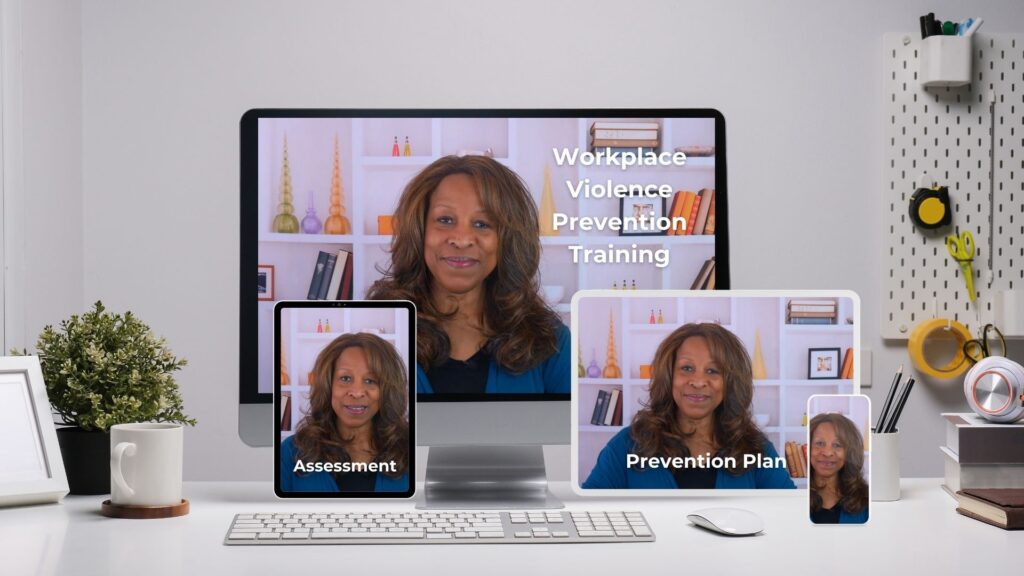Workplace Violence Prevention Plan – Now It’s Mandatory

By VICKY BROWN
Hey there. Today, we’re tackling a topic that’s crucial for every entrepreneur and business owner out there, especially if you’re operating in California. I’m talking about the new Workplace Violence Prevention Program law, SB 553.
Now, before you switch off, thinking this is just another piece of legislation to worry about, hear me out. This is something that can genuinely make a difference in creating a safer, more supportive environment for your team. And – it’s also a new compliance requirement.
And yes, let’s acknowledge that the thought of creating a violence prevention program from scratch can feel daunting, especially if you’re new to this. But here’s the thing – it’s not just about ticking a box for compliance; it’s about genuinely making your workplace safer for everyone. And the good news? You’re not alone in this. There are steps you can take and resources available to guide you through the process. But more on that later.
So, let’s unpack what this legislation means for you and your business.
First up, let’s get a handle on the basics. You see, workplace violence isn’t just about those extreme cases that hit the headlines. It’s about everything from verbal abuse and bullying right through to physical altercations. Recognizing this broad spectrum is the first step in understanding why the new law is so important. It’s all about ensuring your workplace is a space where everyone feels respected and secure.
Now, you might be wondering, “What does SB 553 require from me?” Well, as of July 1, 2024, California employers with five or more employees are required to implement a Workplace Violence Prevention Program (WVPP). Now there are caveats around if you are pubic facing or not – so just be aware of that. The backbone of the program is a written Workplace Violence Prevention Plan that you’ll need to develop, implement, and maintain. The program also includes conducting risk assessments, providing training, establishing clear reporting procedures, and maintaining records of workplace violence incidents. It sounds like a lot, but stick with me here.
“…workplace violence isn’t just about those extreme cases that hit the headlines. It’s about everything from verbal abuse and bullying right through to physical altercations“
Step two is all about assessing your workplace. Look around you. What are the potential risks? Do you have late-night shifts, work in isolated areas, or deal with volatile situations? Assessing your specific environment and the nature of your work will help you identify where you might be vulnerable and what specific measures you need to put in place to comply with the new law.
Next up, drafting your policy. Amount other things, it should clearly state that violence and harassment are not tolerated and outline what behaviors are considered unacceptable. It should also detail how employees can report concerns and the consequences for violating the policy. Clarity is key here. You want everyone to understand the rules and feel comfortable speaking up if they need to.
Training your team is where the rubber meets the road. It’s not enough to have a policy on paper; your team needs to know what it means in practice. This includes recognizing warning signs like verbal and non-verbal cues that may indicate someone is becoming agitated, stressed, or aggressive.
And understanding how to de-escalate potentially violent situations, this is a crucial skill. Calming down an individual who’s becoming agitated or aggressive can help prevent a situation from escalating into violence. Training helps keep this all top of mind.
Establishing reporting procedures is crucial. Make sure your team knows exactly how to report incidents or concerns, and assure them that their reports will be taken seriously and handled confidentially. Having a clear, straightforward process encourages people to come forward, which is crucial in preventing incidents before they escalate. They should know who to report to, how to make the report (whether verbally, in writing, or through a specific online system), and what information needs to be included in the report.

Check out our Violence Prevention Toolkit.
This handy toolkit has everything you need
- User-friendly
- Aligned with the requirements of SB 553
- Template Violence Prevention Plan
- Training for your team
- The forms and notices you need to get and stay compliant
- One on one support to get your plan implemented
If you’re feeling overwhelmed, remember, we’re here with the resources to help you, from templates and guidelines to professional advice.
Next up is your response. What happens when an incident occurs? Having a response plan in place ensures you’re not caught off guard. It should include immediate steps to ensure safety, how to support affected employees, and how to investigate and document the incident.
Lastly, remember that your violence prevention program isn’t set in stone. It should evolve as your business grows and changes. Regularly review and update your policy, training, and procedures to make sure they’re still effective and relevant.
Now, I know, creating a workplace violence prevention program might seem like a big task (who am I kidding – it seems like a huge task) but breaking it down into manageable steps can make it much more approachable.
And we’ve something to help you get your program up and running – use the link in the show notes to learn more about our Violence Prevention Plan Toolkit. We’ve made it user-friendly and aligned with the requirements of SB 553. The toolkit includes a template Violence Prevention Plan, training for your team, and the forms and notices you need to get and stay compliant.
So, if you’re feeling overwhelmed, remember, we’re here with the resources to help you, from templates and guidelines to professional advice. You’ve got this, and your business will be all the better for it.
Spread the word
MORE HUMAN, MORE RESOURCES
310.308.7680 option 1
hello@idomeneoinc.com

